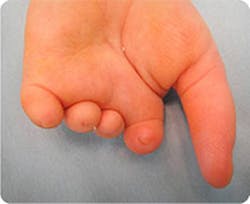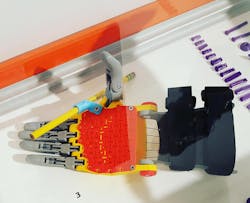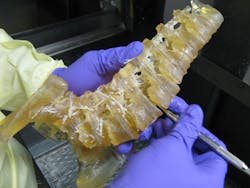The medical industry is unavoidable. From birth, almost everyone has been aided by some kind of medical device. While it can be a difficult market to track, since “medical device” can be a bit vague, research from the Business Monitor International (BMI) shows that it represents about a nickel for every dollar spent in the medical field. This article will review some ways 3D printing is helping reduce the cost of medical devices and helping to get them where they are needed the most.
Cost-effective Prosthetics
Regulations can increase time to market and cost of medical devices. Fortunately for 3D printing, the process is not what is regulated. If the material is approved and the final product’s properties fit within the regulations, how it was made isn’t important. Also, not all medical devices follow the same regulation.
The Food and Drug Administration (FDA) website explains that it “has established classifications for approximately 1,700 different generic types of devices and grouped them into 16 medical specialties referred to as panels. Each of these generic types of devices is assigned to one of three regulatory classes based on the level of control necessary to assure the safety and effectiveness of the device,”
The three classes from the FDA are as follows:
Class I – These devices present minimal potential for harm to the user and are often simpler in design than Class II or Class III devices. Examples include enema kits and elastic bandages. 47% of medical devices fall under this category and 95% of these are exempt from the regulatory process.
Class II – Most medical devices are considered Class II devices. Examples of Class II devices include powered wheelchairs and some pregnancy test kits. 43% of medical devices fall under this category.
Class III – These devices usually sustain or support life, are implanted, or present potential unreasonable risk of illness or injury. Examples of Class III devices include implantable pacemakers and breast implants. 10% of medical devices fall under this category.
Exempt – If a device falls into a generic category of exempted Class I devices, a premarket notification application and FDA clearance is not required before marketing the device in the U.S. However, the manufacturer is required to register its establishment and list its generic product with the FDA. Examples of exempt devices are manual stethoscopes, mercury thermometers, and bedpans.
From this it looks like the majority of medical devices can be 3D printed with minimal to no worry about regulations. Less-regulated Class I devices, have been making some of the biggest impacts in the medical field. These are generally medical devices used outside the body, such as custom hearing aids and prosthetics.
Symbrachydactyly it is a congenial disease that can lead to babies being born with no fingers, or short fingers, typically on one hand. Making prosthetics for growing children can become too costly, but thousands have now been helped with 3D printing and organizations like e-Nable.
Prosthetics have been changing many lives. There are millions of people afflicted with diseases or injuries that have cause the loss of a limb. In many of these cases custom prosthetics are not an option. Babies will grow out of an expensive prosthetics faster than they outgrow clothes, and at potentially thousands of dollars per prosthetic, this is not feasible. In undeveloped and/or war-torn areas, access to care and the money needed for prosthetics aren’t easily accessible.
E-Nable is just one organization that is lending a hand. It was started in 2013 as a simple Google+ group by Jon Shull. The plan was simple enough—if you need a 3D printed hand, or knew someone who does, put a pin on their location on a map. If you have a 3D printer and want to lend a hand, put a pin on your location on the map. From there it was as simple as connecting the pins. Today, more than 70,000 people have had their lives changed by this simple pairing of supply and demand.
For the past few months, the amazing team at Design Museum Portland and the Center for Contemporary Art & Culture at Pacific Northwest College of Art (PNCA) has been working hard to put together an incredible exhibition and educational program to showcase the past, present, and future of prosthetic design: Bespoke Bodies. This pencil and pen attachment was created by five-year-old Cam and his mom Sarah Haight of Different Heroes. They have not only been creating free 3D printed hands and arms for other kids like Cam who were born missing fingers, but they have been brainstorming ideas and designing tools to share back to the global community.
There are other organizations and companies that are working on utilizing more 3D printing with prosthetics. This allows for quick generation of custom fingers, hands, legs, and more, for much cheaper that traditional methods. There are open source communities that could have a basic design that can be customize with free online CAD software, and printed cost effectively. In one example, $5 of material was quoted for an e-Nable hand. An article on medicalfuturist.com said a simple finger splint can be printed in 10 minutes with about $0.02 of materials. By reducing the cost of prosthetics, 3D printing is letting people be more self-sufficient and gain confidence.
Hard-to-Reach Areas
An article in the Guardian mentioned having, “A shortage of 40,000 trained prosthetists in poorer countries. There is also the time and financial cost to patients, who may have to travel long distances for treatment that can take five days—to assess their need, produce a prosthesis, and fit it to the residual limb. The result is that braces and artificial limbs are among the most desperately needed medical devices.”
Have 3D printer, will travel: This novel printer by Kijenzi is robust and easily fits into a duffel bag to get to areas that are in need.
In some poorer areas, or areas that have been hit by natural disasters, it can be difficult to get what is needed to where it is needed. The United Nations Office for the Coordination of Humanitarian Affairs (UNOCHA) estimates that 164.2 million people on the planet received some form of humanitarian assistance, and that number is likely to grow in coming years.
“Supply chain logistics for humanitarian responses are some of the most complex that exist,” noted a study on Development of a Resilient 3-D Printer for Humanitarian Crisis Response. “It is challenging to forecast both the demand (due to difficulties in knowing both the timing of a disaster and details of the population affected) and the supply, which is often fueled by donations. A massive mismatch between the supplies delivered and the supplies that are needed is often inevitable both in quantity and kind. As 60–80% of all aid money is spent on procurement, this mismatch represents not only costly errors but errors that can have negative long-term effects on local markets and economies.”
An organization called Refugee Open Ware has already explored different ways of localizing the manufacturing of items needed in a crisis, especially with 3D printing. ROW had trials in Haiti, Nepal, Syria, and several other countries, where they created items for:
- Water access
- Sanitation
- Health
- Camp management
- Shelter
- Nutrition
- Protection
- Education
- Logistics
- Telecommunication
- Early recovery efforts
One of the biggest items ROW works on is prosthetics. The study goes on to explain the Kijenzi 3D printer. It was designed to be transported a duffel bag and assembled anywhere. Furthermore, the printer can be run off of solar panels for areas without power.
A swarm of five Kijenzi 3D printers were evaluated for rapid part manufacturing for two months at health facilities and other community locations in both rural and urban areas throughout Kisumu County, Kenya. They were successful for their ability to function independently of infrastructure, transportability, ease of use, ability to withstand harsh environments, and costs.
While 3D printing is grabbing headlines in new advanced 3D bio-printing, the less advanced plastic extrusion method that might be sitting in many people’s home shops are changing the world for many people. Just because regulations are in place to keep people safe doesn’t mean they are standing in the way of getting things done. From simple 3D printed medical devices to cost-effective prosthetics, 3D printing is just getting started in the medical field.
Medical Models
While working in undeveloped areas might sounds like a way to get around regulations, modern hospitals are also using 3D printing to improve medical care. Medical models used as a reference don’t have to worry about regulation. However, a simple model can offer a 3D representation that a 2D CT or MRI just can’t offer.
In some case doctors have been able to significantly reduce time in surgery. Doctors have also been able to reduce how invasive the surgery has to be, greatly reducing recovery time.
Carlos Villamizar, a medical engineer technician at Walter Reed Army Medical Center, uses a dental pick to scratch between the crevices of a 3D “medical model,” or replica, of a male patient’s lumbar spine. Walter Reed’s 3D Medical Applications Center uses technology originally designed for the manufacturing industry to cut down on the amount of time a patient is in surgery by as much as six hours. (Defense Dept. photo by Fred W. Baker III)
These are models that match the patient exactly. A CT or MRI provides 2D images of the patient’s body. Each image is another layer that can be viewed like a flip book of images. These are stored as DICOM files. A doctor can select targeted areas and have the files transferred into a file format, such as an STL file, to be 3D printed. By holding an exact 3D copy of the area a doctor is concerned with, faster and better diagnostics can be made. Also, by printing out larger scale versions a doctor can see features that might have been missed on the CT or MRI.
According to a paper from Formlabs: “Widespread use of advanced visualization in radiology has been key for diagnosis and communication among physicians…software developers have recently created tools to reconstruct diagnostic images as 3D anatomic renderings. 3D printed models are a natural progression from these various 3D visualization options, and offer many additional benefits, such as tactile feedback and other tangible information, that visualizations cannot.”
“Access to the model changed the standard treatment indicated by the CT scans from a four-hour complex osteotomy to a simple, much less invasive 30-minute soft tissue procedure,” said Dr. Michael Eames. The successful surgery saved the hospital an estimated $5,500. In addition, the patient needed less postoperative care and recovered faster.
From the FDA classes of regulations, we see not everything has to follow strict guidelines. 3D printing will continue to change the medical field with advanced living tissue, and regulations will play an important role. However, this innovative process has already been changing the medical field for years with prototypes, devices, models, prosthetics and more in a less regulated, external medical application.





